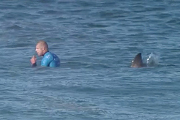Is surfing not extreme enough for you? No problem, try Big Wave (or tow-in) Surfing on walls of water that measure at least 20 feet tall. It’ll blow you away, if it doesn’t drag you under.
What is Big Wave Surfing?
Big Wave Surfing is a form of surfing where daring riders paddle (or are towed) out to waves that measure at least 20 feet tall. Since the larger waves require more balance, a larger than average board is used. This increases the rider’s stability but decreases his ability to maneuver on the water. While many surfers are concerned with riding normal sized waves with style and grace, big wave riders are concerned mostly with staying on the board.
What are the dangers of Big Wave Surfing?
In addition to carrying all the risks of regular surfing, big wave surfing has inherently more danger than its less extreme forerunner. Because the waves are so much larger than normal surfing, the wipeouts a big wave surfer makes are exponentially more dangerous. In fact, the average big wave rider is pushed beneath the water some 20 to 50 feet. Getting caught under multiple big waves can be deadly. The advent of tow-in surfing, a form of big wave riding where a small boat tows a rider onto a wave, is partially connected with having a safety crew available onsite and immediately. After dropping the rider onto the wave, the tow-in boat becomes a safety vessel, working to get the rider back to the beach in one piece.
Who are the best Big Wave Surfers?
While there are many notable big wave riders like Ken Bradshaw, Jeff Clark and Greg Noll, the undisputed king of Big Wave Surfing is American rider Laird Hamilton. Hamilton is credited with inventing “tow-in” surfing; and Hamilton has since ridden some of the biggest and most dangerous waves in the world.
On August 17, 2000, Hamilton rode what is considered the biggest of the big waves ever. That day Hamilton dropped onto a monster wave of water in Tahiti's famed Teahupo'o break, knowing that the slightest misstep could lead to death. The monster he rode that day, now commonly referred to as “The Wave”, rose to over 35 feet tall and crested at speeds in excess of 30 miles an hour. Even Hamilton’s tow-in crew thought it was too much and pleaded with the rider to not let go of the rope. But it was too late. Hamilton had found his feet on the giant and rode it into the shore. Big Wave Surfing had found its high water mark, and would never be the same again.
Related Stories:






























